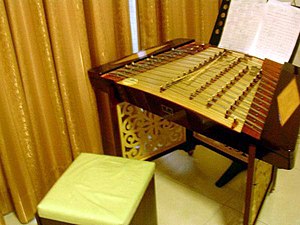This article needs additional citations for verification. (October 2024) |

The trapezoidal yangqin (simplified Chinese: 扬琴; traditional Chinese: 揚琴; pinyin: yángqín; Jyutping: joeng4 kam4) is a Chinese hammered dulcimer, likely derived from the Iranian santur or the European dulcimer. It used to be written with the characters 洋琴 (lit. "foreign zither"), but over time the first character changed to 揚 (also pronounced "yáng"), which means "acclaimed". It is also spelled yang ch'in. Hammered dulcimers of various types are now very popular not only in China, but also Eastern Europe, the Middle East, India, Iran, and Pakistan. The instruments are also sometimes known by the names "santoor" and "cymbalom". This instrument had an influence on the Thai classical instrument, known as Khim (ขิม).
The yangqin was traditionally fitted with bronze strings (though older Chinese stringed instruments used silk strings, resulting in their, and the yangqin's, categorisation as a silk, or "si" instrument), which gave the instrument a soft timbre. This form of instrument is still occasionally heard today in the "hudie qin" (蝴蝶琴, lit. "butterfly zither") played in the traditional silk and bamboo genre from the Shanghai region known as Jiangnan sizhu (江南絲竹), as well as in some Cantonese music and Chaozhou (Teochew) music groups. The Thai and Cambodian khim are nearly identical in their construction, having been introduced to those nations by southern Chinese musicians. Since the 1950s, however, steel alloy strings (in conjunction with copper-wound steel strings for the bass notes) have been used, in order to give the instrument a brighter, and louder tone. The modern yangqin can have as many as five courses of bridges and may be arranged chromatically. Traditional instruments, with three or more courses of bridges, are also still widely in use. The instrument's strings are struck with two lightweight bamboo beaters (also known as hammers) with rubber tips. A professional musician often carries several sets of beaters, each of which draws a slightly different tone from the instrument, much like the drum sticks of Western percussionists. The yangqin is used both as a solo instrument and in ensembles.